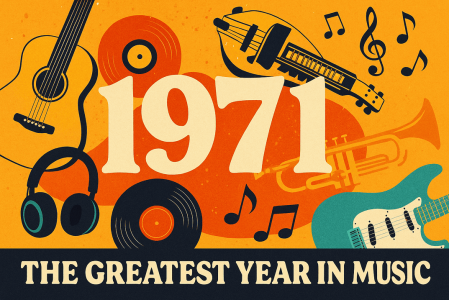The year 1971 stands out as a turning point in music history. It gave us a rare mix of creativity, bold ideas, and lasting impact. Artists across genres were pushing boundaries, and their work still echoes today.
Coming off the energy of the 1960s, the world was in flux. The music reflected this change. With no digital tools yet, artists relied on pure talent and analog gear to create rich, timeless sounds.
The Albums That Defined a Generation
1971 delivered a lineup of albums that changed music forever. These records didn’t just top charts—they shaped genres and set new standards for what albums could be.
Marvin Gaye – What’s Going On: A soul masterpiece with deep social commentary. Gaye turned personal pain and political unrest into a smooth, powerful concept album that still feels urgent today.
Joni Mitchell – Blue: A raw, emotional dive into love, loss, and identity. Mitchell’s songwriting redefined what confessional music could be and influenced generations of singer-songwriters.
Led Zeppelin – Led Zeppelin IV: Blending hard rock, folk, and blues, this album proved the band’s range. “Stairway to Heaven” alone became a blueprint for epic rock tracks.
Carole King – Tapestry: With heartfelt lyrics and timeless melodies, Tapestry brought a woman’s voice to the front of pop and singer-songwriter movements. It was personal and universal at once.
David Bowie – Hunky Dory: A pivot toward glam and art rock, Hunky Dory showcased Bowie’s growing ambition. It marked the birth of his many reinventions and helped set the tone for the ‘70s.
Each of these albums didn’t just define 1971—they continue to inspire artists and listeners more than 50 years later.
The Explosion of Genre Diversity
In 1971, music wasn’t just evolving—it was exploding in every direction. Soul, rock, folk, and funk were all reaching new heights, each with its own voice and energy.
Soul music got deeper and more political with artists like Marvin Gaye and Curtis Mayfield. Rock split into multiple branches—from the heavy riffs of Led Zeppelin to the prog experiments of Yes. Folk was moving beyond tradition, with Joni Mitchell and others writing more personal, poetic songs. Funk was on the rise, with James Brown and Sly and the Family Stone bringing rhythm to the forefront.
Genres also started blending in bold ways. Jazz fusion took shape, mixing complex jazz rhythms with electric rock sounds. Prog rock pushed musical boundaries with long, layered compositions and concept albums. Even the roots of hip-hop were beginning to take form in spoken word and rhythmic soul tracks, laying early groundwork for the genre’s rise.
This genre diversity made 1971 a year where no sound dominated—everything had room to grow, shift, and shine.
Sociopolitical and Cultural Resonance
In 1971, music wasn’t just entertainment—it was a mirror of the world. Artists used their platforms to speak out on war, racism, and social change. With the Vietnam War still raging and the civil rights movement shifting into new phases, musicians turned emotion into action.
Marvin Gaye’s What’s Going On was a direct response to the chaos of the time. Songs like “Mercy Mercy Me” and “Inner City Blues” gave voice to environmental concerns, inequality, and urban struggle—all wrapped in lush, soulful sound.
Gil Scott-Heron’s Pieces of a Man mixed jazz, soul, and spoken word to deliver sharp critiques of injustice. His track “The Revolution Will Not Be Televised” became an anthem for awareness and resistance, foreshadowing both hip-hop and modern protest music.
Other artists like John Lennon (“Imagine”), and The Who (Who’s Next) also tapped into the cultural mood—whether through hope, rebellion, or sharp observation.
Music in 1971 didn’t look away. It engaged with the world head-on, giving people both a soundtrack and a sense of solidarity.
Commercial Success Meets Artistic Integrity
In 1971, artists didn’t have to choose between chart success and creative freedom—they achieved both. It was a rare moment when some of the most groundbreaking albums also became best-sellers.
Carole King’s Tapestry dominated the charts while redefining pop songwriting. Led Zeppelin IV sold millions without releasing singles, relying purely on the power of the music. What’s Going On and Blue were praised by critics and loved by the public, proving that thoughtful, personal work could thrive in the mainstream.
Behind the scenes, a shift was happening. Artists were gaining more control over their sound. They took bigger roles in writing, arranging, and producing their own music. Labels, seeing the success, started giving them more space to create.
This new balance meant that 1971 wasn’t just full of hits—it was full of honest, ambitious, and lasting art.
Closing Thoughts
1971 was more than just a great year for music—it was the perfect storm of talent, timing, and truth. Artists across genres were at their creative peak, the world was in flux, and the studio became a space for real innovation. Music didn’t just reflect culture—it helped shape it.
From soul to rock, from folk to funk, the year delivered a legacy of albums that still move us, challenge us, and inspire new generations.
Simply put, no other year combined artistic depth, cultural relevance, and commercial power quite like 1971. It remains unmatched—a gold standard in music history.
